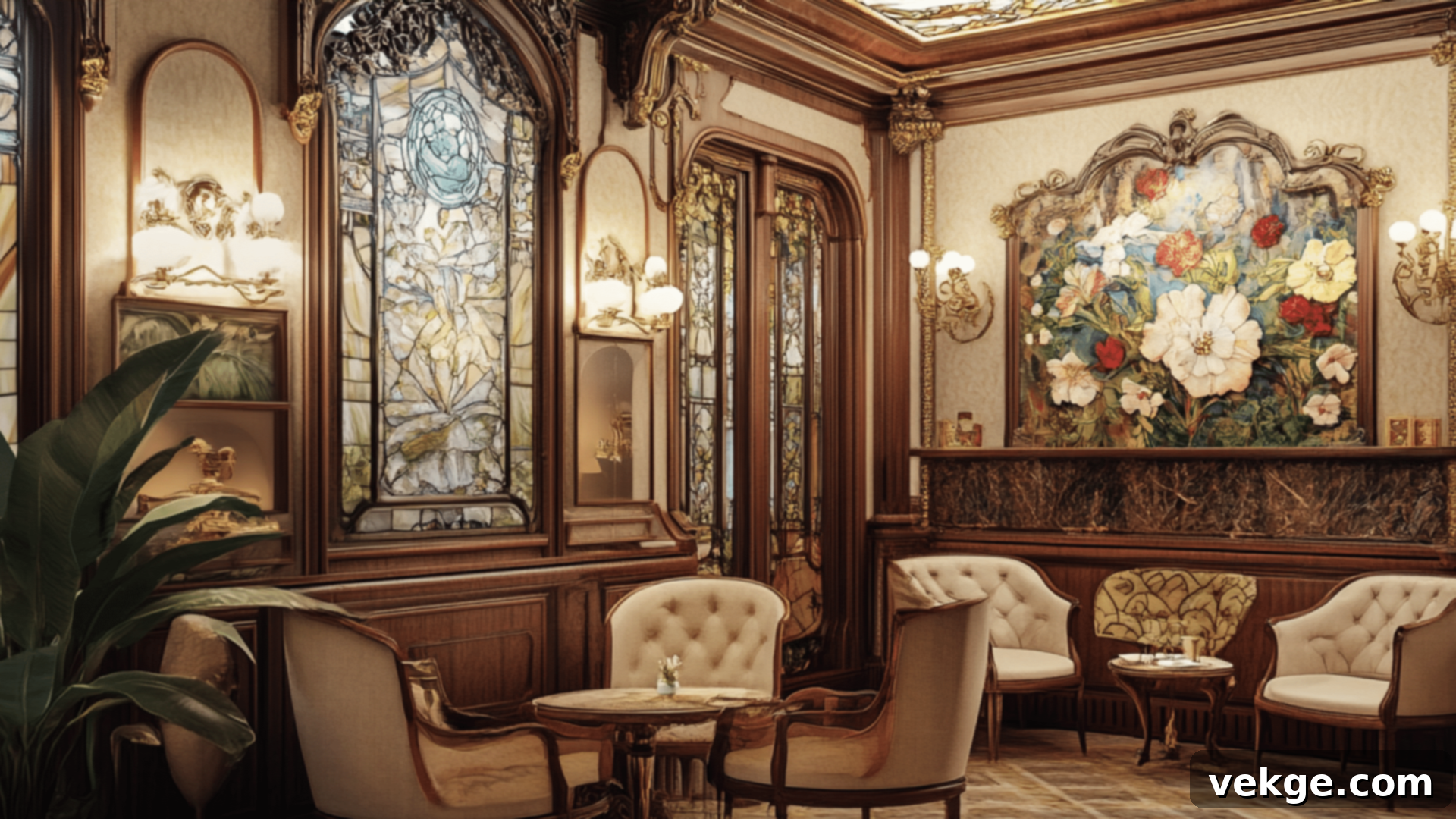Embrace Nature’s Elegance: A Comprehensive Guide to Art Nouveau Interior Design
Seeking to infuse your living spaces with a touch of natural beauty and artistic flair? Art Nouveau interior design offers a captivating solution. Renowned for its graceful, flowing lines, intricate floral patterns, and deeply nature-inspired motifs, this distinctive style effortlessly cultivates a calm, sophisticated, and artistic atmosphere within any home.
But how does one seamlessly integrate this historic and visually rich aesthetic into a contemporary living environment? This detailed guide will unravel the essence of Art Nouveau, explore its defining characteristics, and provide actionable advice on how to incorporate its unique charm into your personal sanctuary.
By the end of this journey, you’ll possess all the knowledge needed to transform your home into a breathtaking, nature-inspired haven, echoing the timeless elegance of Art Nouveau-style interior design.
What is Art Nouveau? Unveiling a Revolutionary Artistic Movement
Art Nouveau, meaning “New Art” in French, emerged as a groundbreaking international artistic movement that flourished between approximately 1890 and 1910. It stands in stark contrast to the rigid, academic styles that preceded it, championing smooth, sinuous lines and shapes directly inspired by the organic forms found in nature, such as winding vines, delicate flowers, and the gentle curves of the human body.
This innovative style permeated nearly every aspect of artistic expression, influencing architecture, furniture, graphic design (posters, book illustrations), jewelry, ceramics, glasswork, and textiles. Its core philosophy was to elevate everyday objects into works of art, rejecting the prevailing historicism and the perceived soullessness of mass-produced goods during the Industrial Revolution. Art Nouveau sought to create a holistic “total work of art” (Gesamtkunstwerk), where every element of a space contributed to a unified, beautiful experience.
History and Origin: A Response to Industrialization
The genesis of Art Nouveau can be traced to the late 19th century, a period marked by rapid industrialization and the proliferation of factory-made items. Artists and designers of the era felt a strong desire to reintroduce craftsmanship, beauty, and individuality into objects that had become standardized and uninspired. It was, in many ways, an aesthetic revolt against the past and a yearning for a fresh, modern expression.
The movement gained significant momentum in major European cities, with prominent centers in Paris, Brussels, Glasgow, Vienna, and Barcelona. Iconic figures such as Hector Guimard, whose elegant ironwork graces the entrances of the Paris Metro, became synonymous with the style. Louis Comfort Tiffany’s exquisite stained-glass lamps, with their luminous, nature-inspired motifs, captivated audiences, while Alphonse Mucha’s highly stylized and ornamental posters defined graphic design for a generation. Other pivotal artists included Gustav Klimt, known for his opulent and symbolic paintings, Charles Rennie Mackintosh, a pioneer of the Glasgow Style, and Antoni Gaudí, whose fantastical architecture in Barcelona seamlessly blended Art Nouveau with Catalan Modernism and Islamic influences, creating a truly unique local flavor while adhering to the style’s fundamental principles.
Evolution of the Movement: From Organic Forms to Streamlined Silhouettes
Art Nouveau drew heavily from the earlier Arts and Crafts movement, sharing its deep appreciation for handmade items and skilled artisanship. However, Art Nouveau pushed the boundaries further, embracing new materials and more expressive, often asymmetrical forms. The style exhibited fascinating regional variations as it spread across Europe and beyond. In Germany, it evolved into Jugenstil, which often featured a more austere, linear, and clean aesthetic. In Spain, particularly through Gaudí’s work, it took on a more sculptural and often fantastical quality, incorporating intricate mosaic work and bold structural elements.
Art Nouveau artists were pioneers in experimenting with modern materials like cast iron, steel, and glass, incorporating them into their designs not just for structural integrity but also for their decorative potential. This belief that even the most functional objects could and should be beautiful, provided they were well-designed, had a profound impact on subsequent art and design movements, including Art Deco and early Modernism. The movement remained dominant until the outbreak of World War I, after which public taste began to shift towards simpler, more geometric, and functional styles, leading to Art Nouveau’s gradual decline. Nevertheless, its legacy endures, profoundly shaping how we perceive and value design today.
Key Features of Art Nouveau Design: Elements of Natural Beauty
Art Nouveau was not merely a decorative trend but a comprehensive design philosophy, characterized by several distinctive features that set it apart and contribute to its enduring allure.
1. Flowing Organic Shapes: The Language of Nature’s Curves
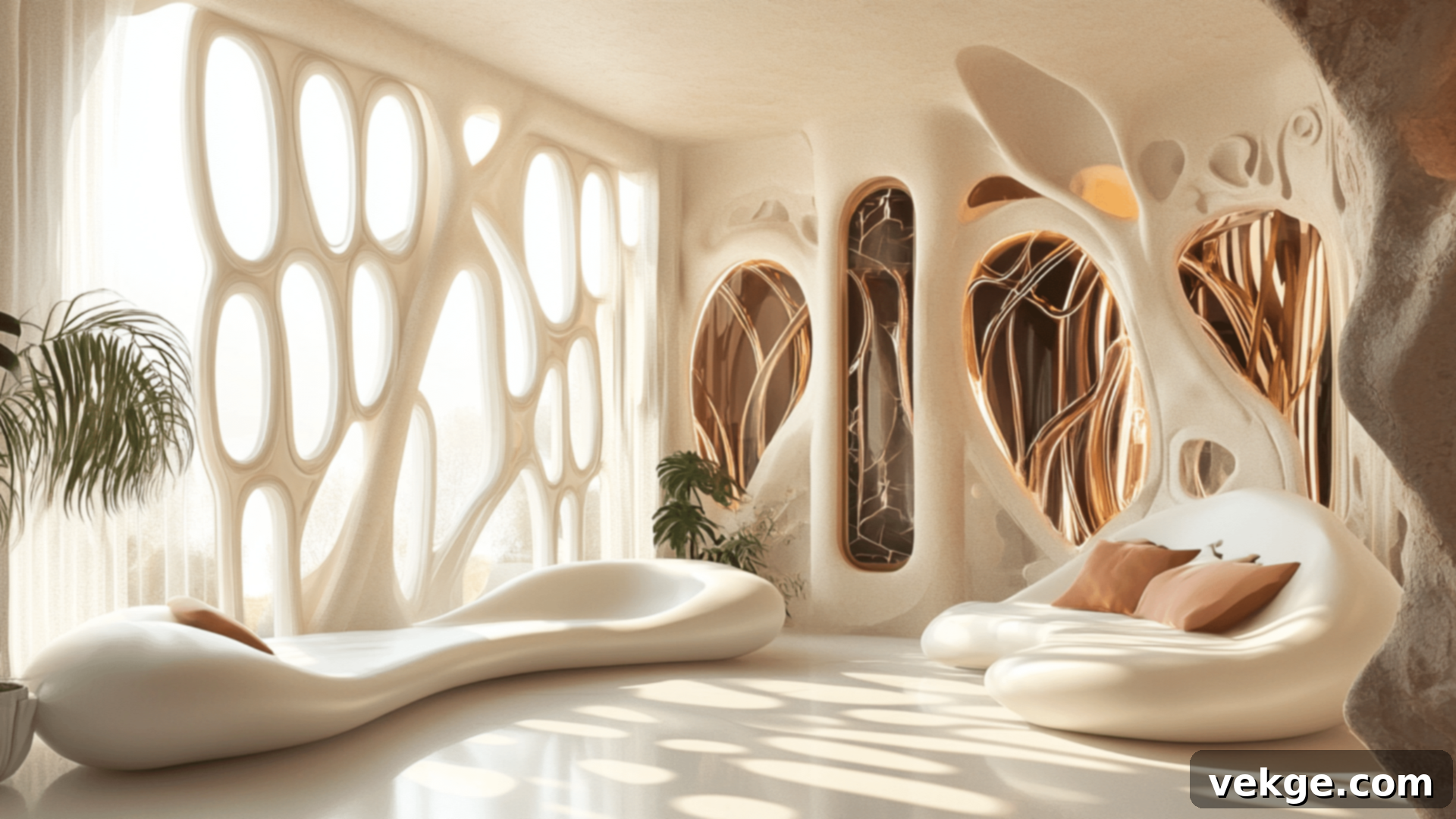
At the heart of Art Nouveau is an unmistakable adoration for natural curves and sinuous lines. Artists meticulously crafted forms that mimic the dynamic growth of vines, the delicate unfurling of leaves, and the gentle swell of a flower petal. These soft, smooth, and often asymmetrical shapes are directly inspired by plant structures and the graceful fluidity of living organisms, becoming the signature of the style. These organic forms are not just decorative; they convey a sense of movement, life, and continuous growth, making designs feel alive and responsive.
To infuse your home with this fundamental Art Nouveau characteristic, prioritize furniture and décor pieces that feature smooth, continuous, and flowing lines. Opt for chairs, tables, and cabinets with curving silhouettes, rather than sharp angles. Incorporate decorative elements such as wall art, mirrors, and light fixtures that showcase these serpentine lines and natural contours, creating an immediate sense of organic movement and vitality within your space.
2. Nature-Inspired Motifs: A Garden of Artistic Expression
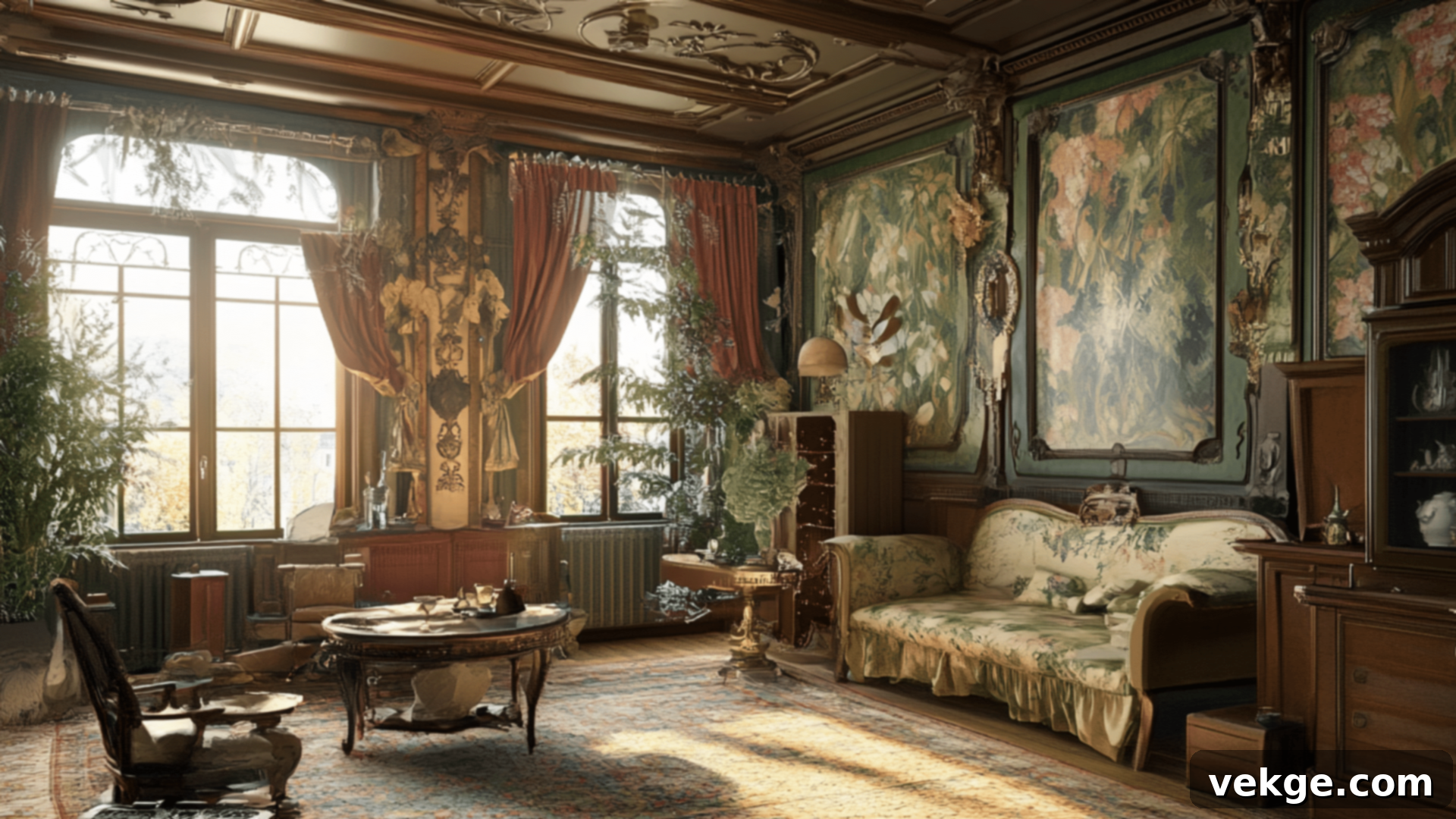
Natural elements are not just a muse but the very fabric of Art Nouveau design. From grand architectural facades to the intricate details of a brooch, flowers, plants, insects (like dragonflies), birds (peacocks), and other organic patterns appear in myriad forms. Artists masterfully transform these natural shapes into highly stylized yet graceful decorations, creating a seamless blend where art and nature converge. This approach imbues everyday objects with a sense of wonder and makes spaces feel vibrant and connected to the natural world.
To integrate these cherished natural elements into your home in an authentic Art Nouveau style, actively seek out and incorporate floral patterns, botanical prints, and organic shapes across various design elements. This could include upholstery, curtains, throw pillows, and wall coverings. Choose artwork and sculptures that feature stylized natural forms, and don’t shy away from adding actual plants to further enhance this connection to nature.
3. Dynamic Curves and Figures: The Whiplash Line and Beyond
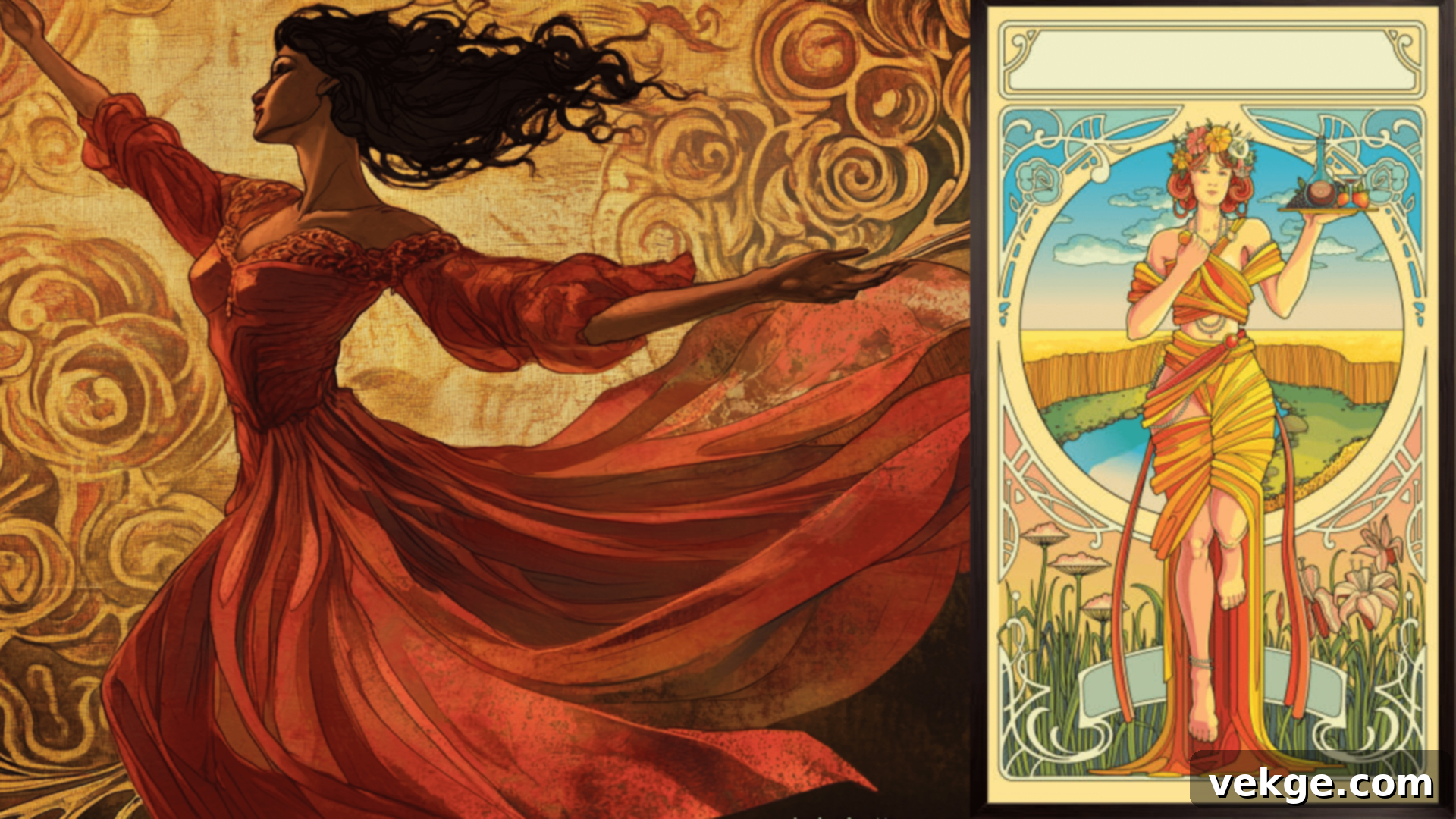
A hallmark of Art Nouveau is the “whiplash line”—a strong, undulating, and often asymmetrical curve that brings immense energy and dynamism to designs. These sweeping, curvilinear lines appear to be in constant motion, embodying a sense of growth and vitality. Human figures, especially female forms, are often depicted with elongated, graceful proportions, their flowing hair and drapery seemingly caught in a gentle dance. These stylized, almost ethereal figures contribute significantly to the rhythmic and fluid quality of Art Nouveau artwork, evoking a dreamlike and expressive quality.
To incorporate the characteristic whiplash lines and dynamic energy into your home’s aesthetic, select furniture and décor with sweeping, serpentine shapes that inherently suggest movement. Look for items where curves dominate, such as a carved wooden console table or a decorative mirror frame. Embellish your space with artwork, sculptures, or decorative panels that feature elongated, graceful figures with flowing lines, adding an immediate sense of poetic motion and artistic drama.
4. Intricate Detailing: A Symphony of Craftsmanship
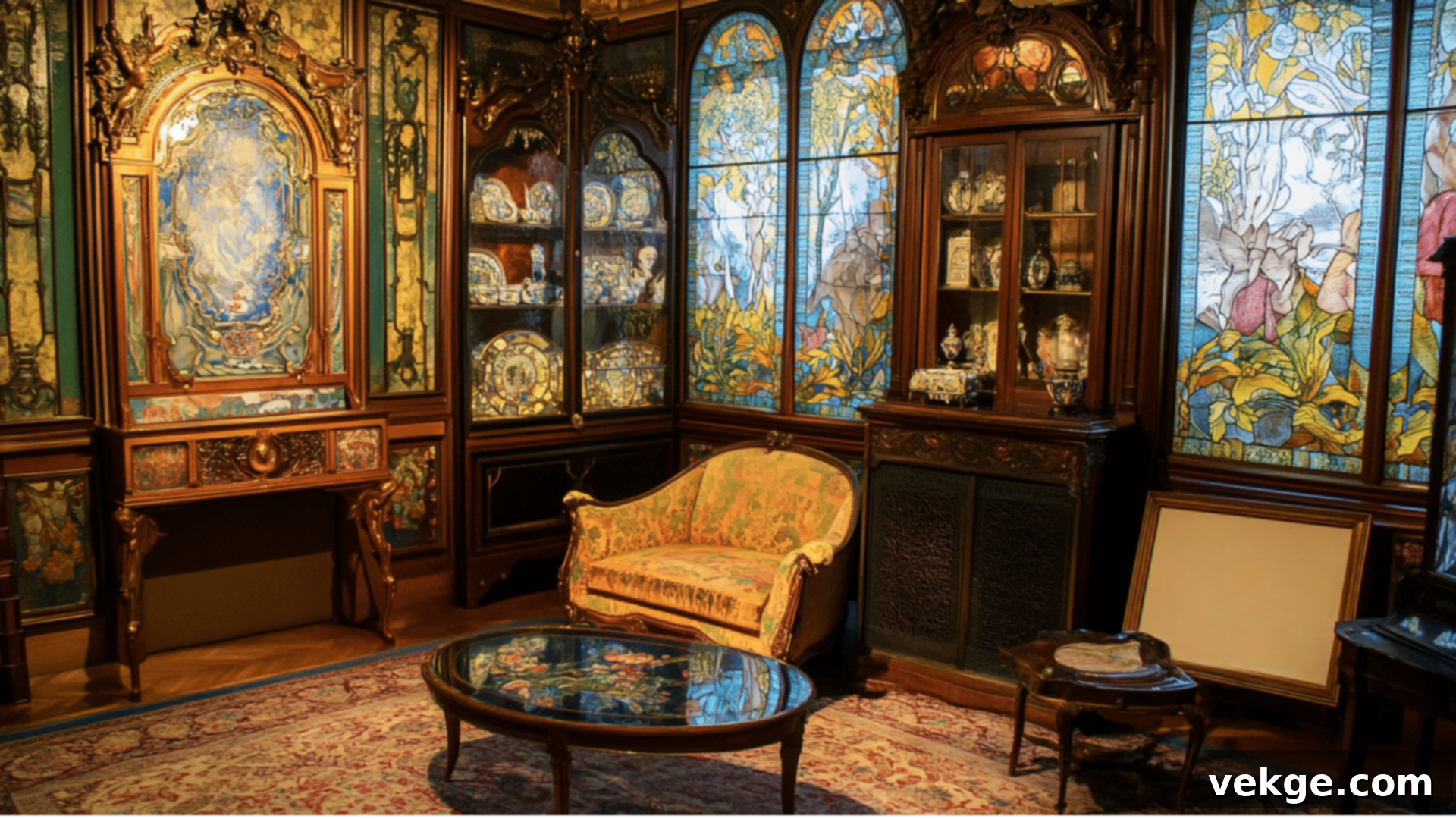
In Art Nouveau, every surface had the potential to become a canvas for elaborate and complex decoration. Artists poured their skill into creating rich, intricate patterns that adorned everything from furniture and metalwork to glass and printed materials. Tiny, meticulous details often emerged in delicate metalwork, shimmering stained glass, and finely rendered print designs. Each piece tells a story through its carefully crafted, ornamental elements, showcasing an incredible level of craftsmanship, artistry, and imaginative flair. This emphasis on detailed work was a direct rejection of the simplicity and anonymity of machine production.
To introduce this signature intricate Art Nouveau decoration into your home, seek out furniture and decorative items that boast detailed patterns, elaborate carvings, or ornamental accents. Prioritize pieces with rich metalwork (bronze, copper), art glass, or meticulously printed designs that highlight fine craftsmanship and creative complexity. These elements elevate every surface, transforming functional objects into exquisite works of art that invite closer inspection and admiration.
5. Color Palette: Hues of Earth and Gemstones
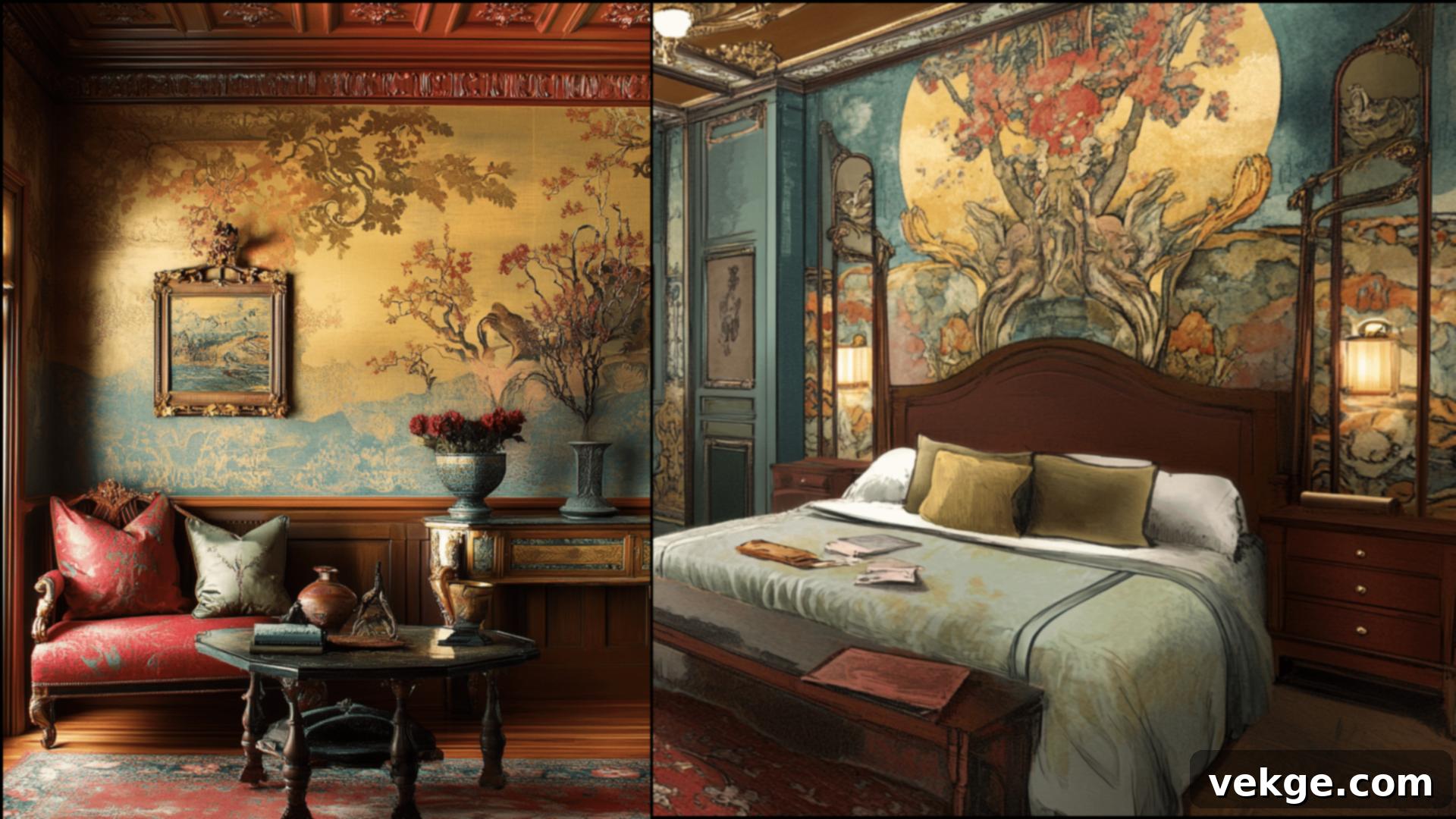
The Art Nouveau color palette is a direct reflection of the natural world, leaning towards organic, muted, and often jewel-toned hues. Earthy greens, soft browns, moss greens, and muted yellows form a grounding base, creating a warm and inviting ambiance. These are often complemented by rich, deep blues, reminiscent of twilight, and profound reds or purples, adding depth, mystery, and emotional resonance. Crucially, metallic touches of gold, brass, and copper are frequently integrated, bringing a shimmering luminosity and an undeniable sense of luxury and opulence to the designs. This combination ensures each piece feels special, unique, and deeply integrated into the natural aesthetic.
To imbue your home with the characteristic Art Nouveau color scheme, employ earthy greens, soft browns, and muted yellows as primary colors for walls, larger furniture pieces, or foundational textiles, establishing a warm and natural foundation. Introduce rich blues, deep reds, or purples through accent pieces like cushions, vases, or artwork to add depth and visual interest. Finally, integrate metallic accents—think gold picture frames, brass light fixtures, or copper decorative objects—to introduce the signature shine and luxurious touch that defines the Art Nouveau aesthetic.
How to Incorporate Art Nouveau in Modern Homes: A Practical Guide
Integrating a historic style like Art Nouveau into contemporary living spaces requires thoughtful curation and strategic placement. Here’s how you can achieve this harmonious blend:
Furniture: Sculptural Elegance and Organic Forms
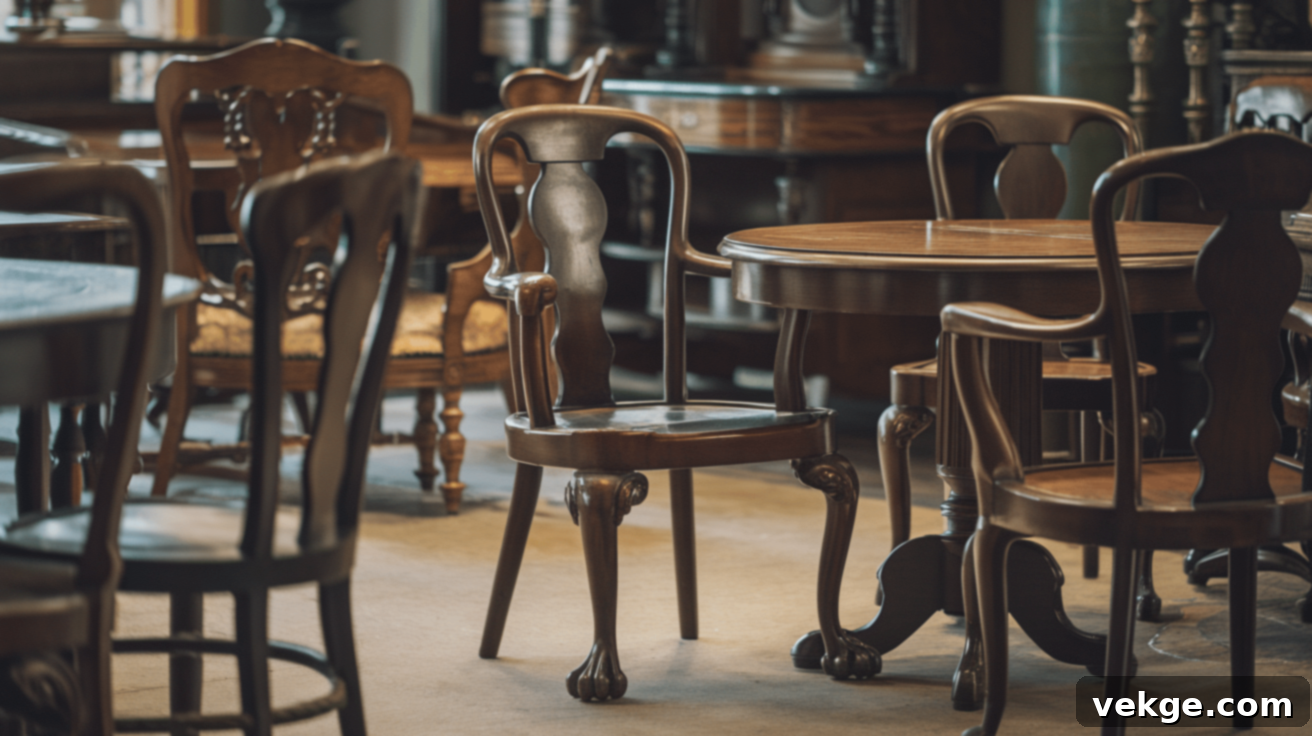
Art Nouveau furniture is celebrated for its emphasis on organic forms and graceful curves, often appearing as living sculptures. Look for pieces such as chairs, tables, cabinets, and display cases that feature smooth, continuous lines, intricate carvings, and marquetry depicting botanical motifs. Designers like Louis Majorelle, Émile Gallé, and Antoni Gaudí crafted furniture that transcends mere functionality, becoming artistic statements in themselves. Common materials include exotic woods like mahogany, walnut, and rosewood, often adorned with metal accents or mother-of-pearl inlays. The goal is to create a seamless flow, connecting your indoor environment with the fluidity of the natural world.
You can introduce this style into your modern home by selecting a few key furniture pieces with these distinctive organic, nature-inspired shapes. A single elegantly carved Art Nouveau-style chair, a console table with sinuous legs, or a cabinet featuring floral inlays can become a striking focal point, effortlessly linking your space to this timeless design movement.
Lighting Fixtures: Illuminating Artistry
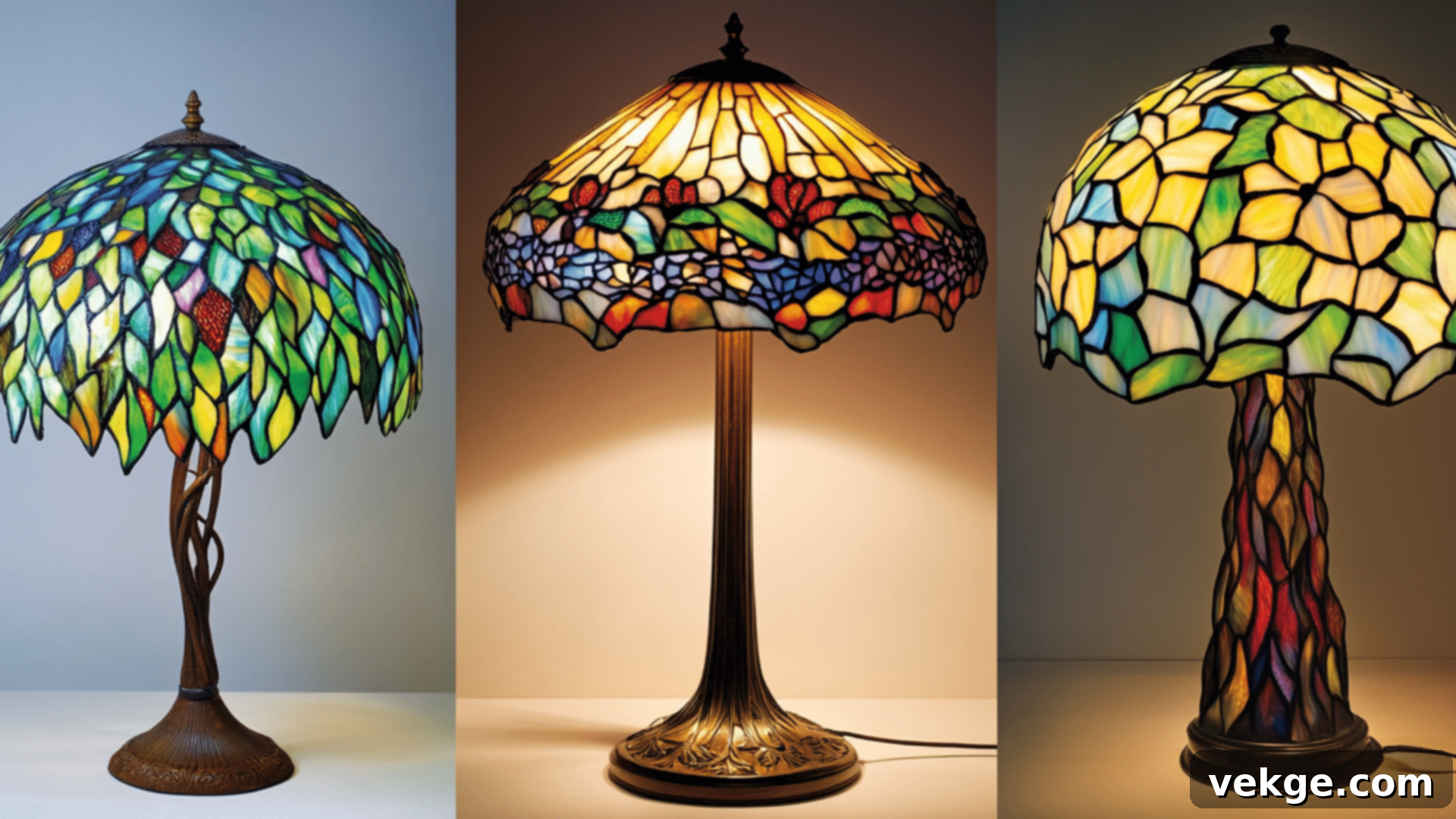
Art Nouveau lighting fixtures are iconic and instantly recognizable. Tiffany lamps, with their exquisite colored glass panels meticulously assembled to create stunning patterns of flower petals, dragonflies, and plant shapes, are perhaps the most famous example. These lamps cast a soft, warm, and inviting glow, transforming any room into an ethereal, nature-inspired sanctuary. Beyond Tiffany, look for sconces, chandeliers, and table lamps crafted from bronze, wrought iron, or brass, often featuring frosted or etched glass shades with floral or female figure motifs.
Incorporating these types of lamps, whether authentic antiques or high-quality reproductions, can powerfully bring the enchanting charm of Art Nouveau into your modern setting, serving as both a light source and a captivating piece of art.
Wallpaper and Wall Treatments: A Botanical Embrace
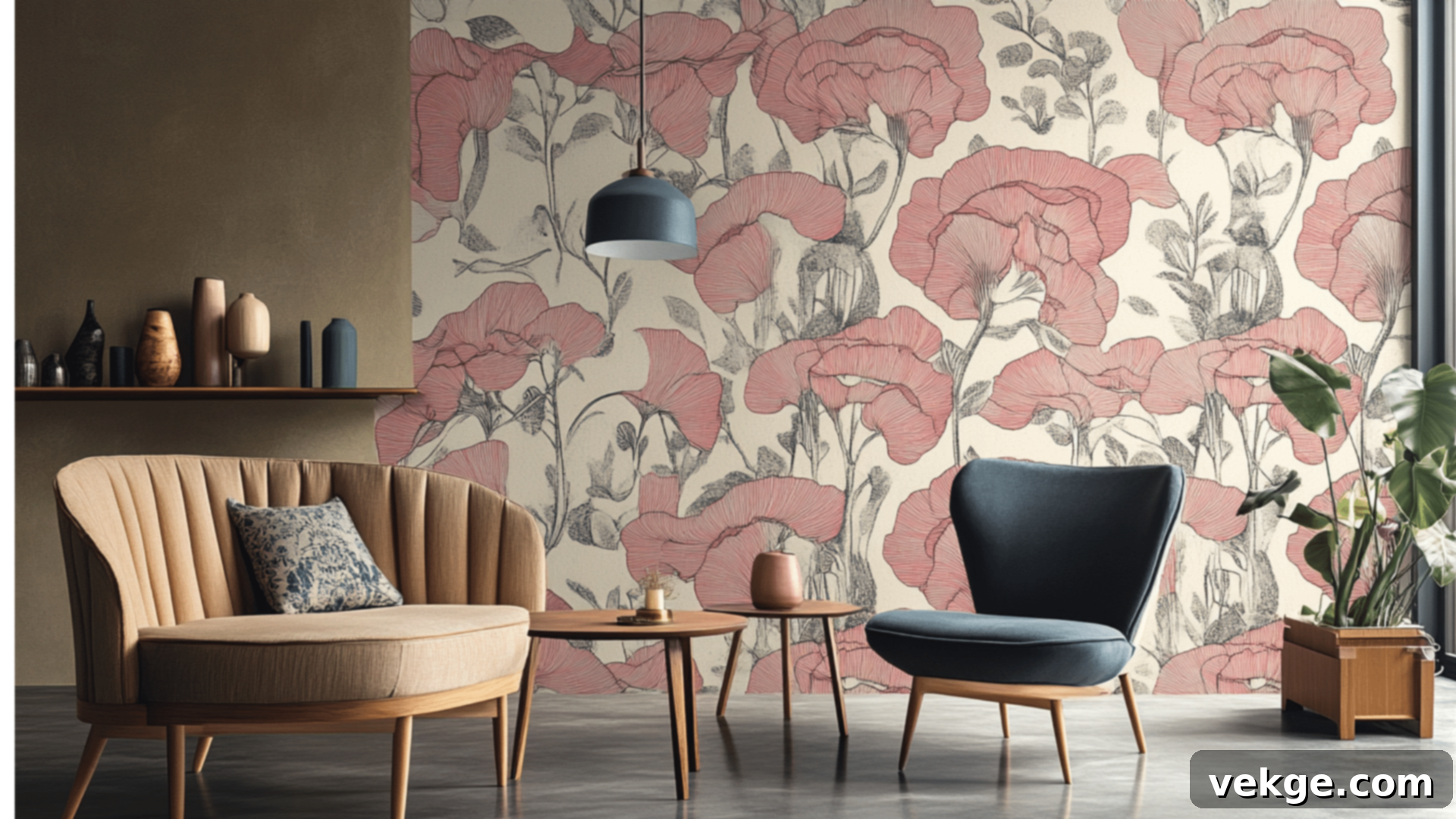
Art Nouveau walls often became canvases for rich, decorative patterns that reinforce the style’s connection to nature and fluidity. Wallpaper and wall treatments featuring sweeping, curving lines, intricate floral motifs (lilies, irises, poppies are common), and stylized botanical elements are quintessential. These patterns introduce dynamic energy and a sense of organic flow to your rooms, enveloping the space in beauty. While original Art Nouveau wallpapers are rare, many modern wallpaper designs draw direct inspiration from this historic style, offering updated color palettes and contemporary interpretations of classic motifs.
To achieve this look, search for wallpapers or even hand-painted stencils with nature-inspired elements, subtle metallic sheens, and flowing lines. Consider using a feature wall to introduce a bold Art Nouveau pattern, or opt for more subdued, textural papers with a naturalistic design throughout the room for a softer effect.
Materials Used: A Rich Tapestry of Craftsmanship
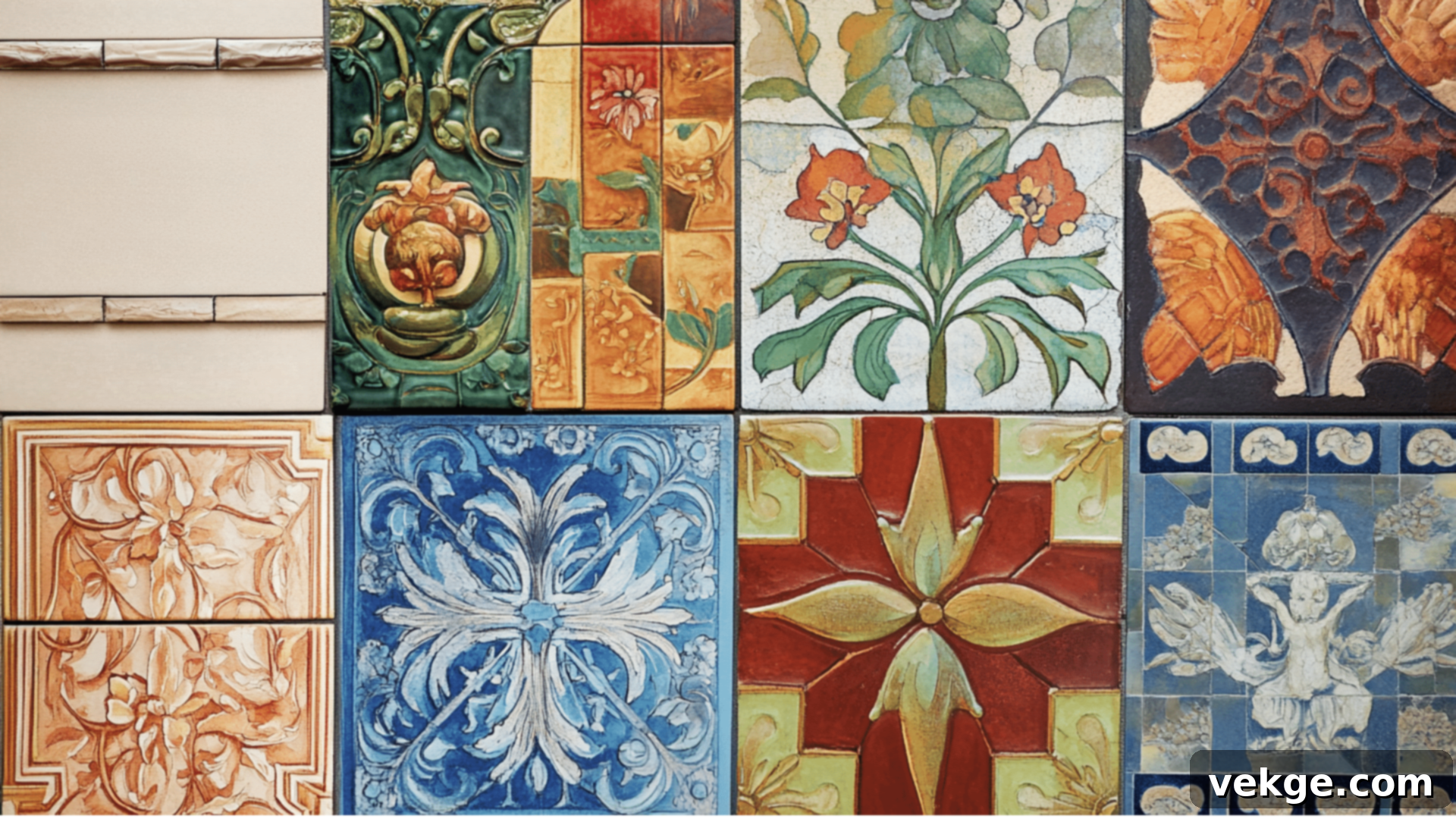
The Art Nouveau style embraces a diverse range of materials, each chosen for its tactile quality, visual interest, and ability to be shaped into organic forms. Parquet wood floors, often laid in intricate patterns, provided a warm and luxurious base. Colorful mosaic tiles, especially in bathrooms and entryways, added shimmering visual interest, while decorative linoleum, a newer material at the time, allowed for bold, flowing patterns on floors. Beyond these, stained glass, wrought iron, bronze, ceramic tiles, and various polished woods were extensively used in furniture, architectural details, and decorative objects.
By incorporating these materials into your home—perhaps a mosaic backsplash in the kitchen, a decorative wrought iron railing, or rich wooden floors—you can authentically connect your space with the masterful craftsmanship and creative spirit that defined original Art Nouveau designs. Consider the textures and natural hues of these materials to enhance the overall organic feel.
Design Features: Graceful Curves and Architectural Flourishes
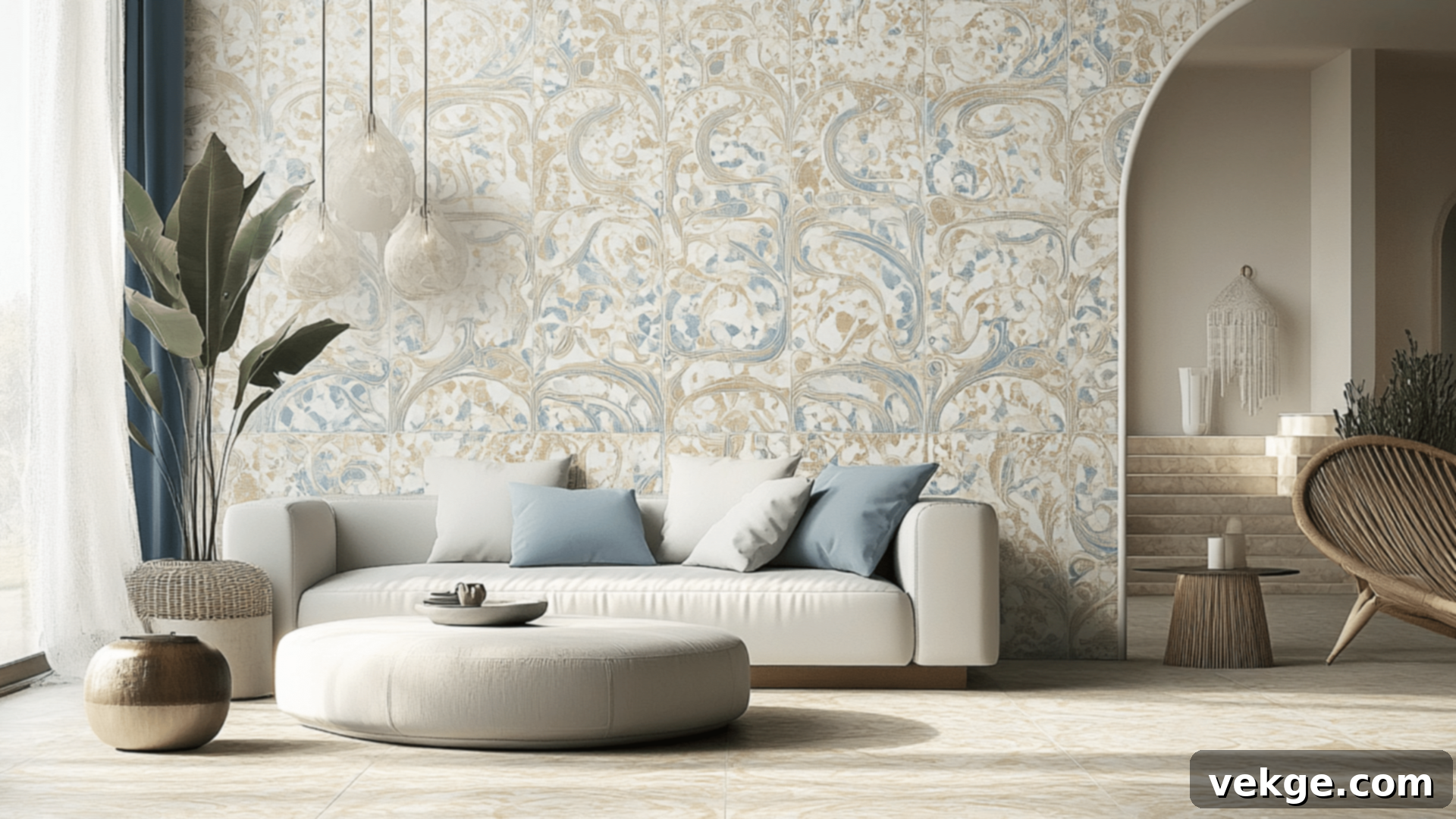
Beyond individual decorative pieces, Art Nouveau can be integrated through architectural and inherent design features. Incorporating soft, swirling S-curve patterns into elements like door frames, archways, or built-in shelving can immediately capture the signature flow and grace of the style. Think about elements like stained glass panels in doors or windows, which are particularly evocative of the period, casting colorful light and featuring botanical or figurative motifs.
Utilize pastel-colored tiles with organic shapes for fireplaces or as decorative accents. Consider decorative ironwork for balconies, staircases, or even as purely ornamental wall hangings. These larger design elements will profoundly transform your rooms, adding an undeniable sense of fluidity, artistry, and historical depth. By thoughtfully mixing these classic features with modern decor, you can seamlessly infuse the captivating spirit of Art Nouveau into your contemporary homes.
Budget-Friendly Tips for Sourcing Art Nouveau Pieces: Elegance on a Dime
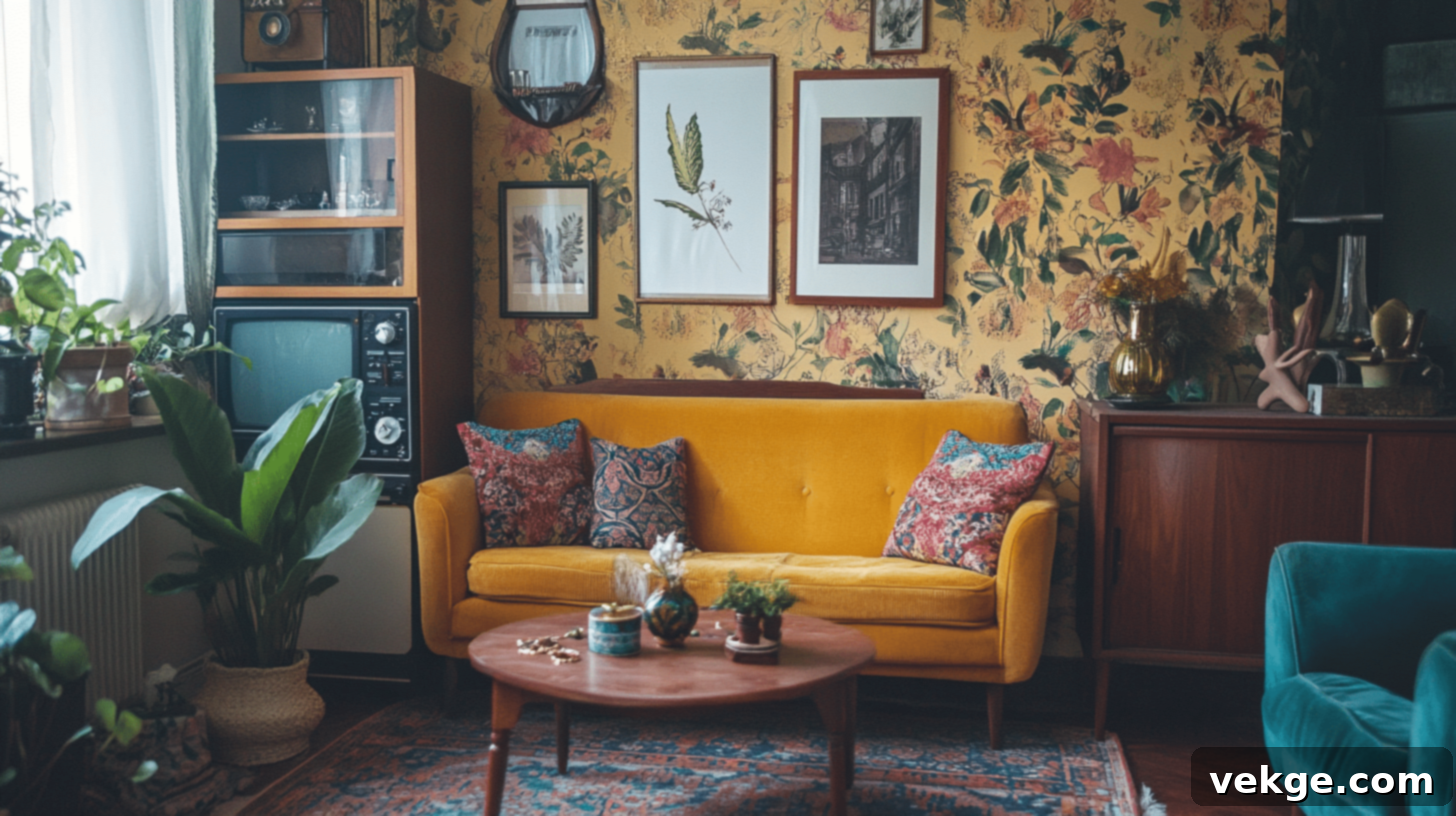
Adorning your home with authentic Art Nouveau pieces doesn’t necessarily require an extravagant budget. With a keen eye and a bit of patience, you can discover stunning treasures. Begin your search at local antique shops, bustling flea markets, and online marketplaces like Etsy and eBay, which are often brimming with unique finds. Vintage stores, second-hand shops, and even estate sales frequently hide surprisingly affordable gems that capture the essence of the style.
For those on a tighter budget, consider high-quality reproduction pieces. Many modern manufacturers create items that faithfully reflect the core aesthetic and intricate details of Art Nouveau, allowing you to enjoy the style without the premium price tag of an original. You can subtly introduce Art Nouveau’s distinctive elegance into your home through various wallet-friendly options:
- Tiffany-style stained glass lampshades: Many affordable reproductions offer the iconic look and warm glow.
- Vintage-inspired wall prints: Look for posters or art prints featuring flowing lines, Alphonse Mucha’s distinctive female figures, or botanical motifs.
- Decorative ceramic vases: Choose vases with curved shapes, often depicting flowers or graceful women.
- Brass or copper picture frames: Frames with organic, etched, or embossed motifs can add a touch of period luxury.
- Reproduction jewelry with nature-inspired designs: Even small items can serve as decorative accents when displayed.
- Throw pillows: Opt for cushions featuring Art Nouveau patterns, especially stylized florals or whiplash curves.
- Small bronze or pewter figurines: Look for figurines with fluid lines, often depicting nymphs or botanical forms.
Budget tip: The most effective strategy is often to mix original, smaller finds with more affordable, high-quality reproductions. Always check estate sales, online auctions, and specialized vintage websites, but also don’t overlook craft fairs or artisan markets that might offer contemporary pieces with a strong Art Nouveau influence. Some museum gift shops also provide excellent, high-quality Art Nouveau-inspired items that enable you to bring this beautiful style home without emptying your wallet.
Art Nouveau vs. Art Deco: Distinguishing Two Eras of Design
While both Art Nouveau and Art Deco represent significant design movements, they emerged at different times and with distinct philosophies and aesthetics. Understanding their differences is key to appreciating their individual contributions to art and design history.
Art Nouveau, as explored, championed the organic, flowing lines and the intricate beauty of the natural world, often embracing asymmetry and handcrafted elegance. In stark contrast, Art Deco, which rose to prominence in the 1920s and 1930s, celebrated the dawn of the machine age, industrial progress, and a more streamlined, geometric aesthetic. It embraced symmetry, bold forms, and luxurious materials that reflected modernity and glamour.
The table below provides a clear comparison of how these two influential styles differ across various aspects, from their primary inspirations to their typical decorative characteristics, helping you discern their unique identities.
| Aspect | Art Nouveau | Art Deco |
|---|---|---|
| Time Period | 1890s to early 1910s | 1920s to 1930s |
| Primary Inspiration | Nature, organic forms, plants, flowers, insects, female figures | Machinery, geometry, modern technology, ancient cultures (Egyptian, Aztec) |
| Design Approach | Asymmetrical, flowing, curvilinear lines, organic shapes, whiplash curves | Symmetrical, bold geometric shapes, sharp angles, stepped forms |
| Color Palette | Soft, muted colors with natural tones (earthy greens, browns, deep blues, purples), metallic accents | Bold, bright, and contrasting colors (black, white, chrome, gold, vivid primary colors) |
| Materials | Handcrafted, emphasis on natural materials (wood, glass, wrought iron, bronze, ceramics) | Machine-made, sleek industrial materials (chrome, stainless steel, glass, Bakelite, exotic woods, lacquered surfaces) |
| Key Visual Elements | Curved lines, plant-like patterns, stylized flora and fauna, elongated female figures | Sharp angles, zigzags, sunburst motifs, chevrons, speed lines, stylized animal figures |
| Typical Decorative Style | Intricate, detailed ornamentation, emphasis on craftsmanship | Clean, streamlined, precise design, often minimalist yet luxurious |
| Architectural Characteristics | Organic, curving structures, elaborate facades, stained glass windows, decorative ironwork | Vertical lines, stepped forms (ziggurats), opulent facades, geometric patterns, sleek surfaces |
| Geographical Origin | Primarily European (France, Belgium, Spain, Austria, Germany, Scotland) | International, with strong roots in France, popular globally (especially in the USA) |
| Cultural Context | Reaction against industrial production, revival of craftsmanship, escapism into nature | Celebration of modern technology, progress, speed, luxury, and glamour of the Roaring Twenties |
Wrapping Up: Embrace the Art Nouveau Lifestyle
Art Nouveau interior design offers a truly wonderful and distinctive way to infuse your home with unparalleled beauty, artistic expression, and a profound connection to nature. By consciously incorporating its signature flowing curves, intricate floral patterns, and diverse, tactile materials, you possess the power to create a living space that feels not only artistic and sophisticated but also deeply peaceful and inviting.
Whether you begin with a single, evocative vintage lamp, adorn your walls with nature-themed wallpaper, or select key furniture pieces boasting smooth, organic shapes, the transformative potential of this style is immense. Each Art Nouveau-inspired element you introduce contributes to a richer, more harmonious environment, allowing your home to tell a story of beauty and refined taste.
Are you ready to give your home a refreshing, art-inspired new look? Start with small, thoughtful touches and gradually build an atmosphere of Art Nouveau elegance. Create a home that beautifully reflects your appreciation for artistry, dedicated craftsmanship, and unbounded creativity—a true sanctuary where form and function dance in perfect harmony.
For more inspiring design ideas and home decor insights, explore additional blogs on our website.
